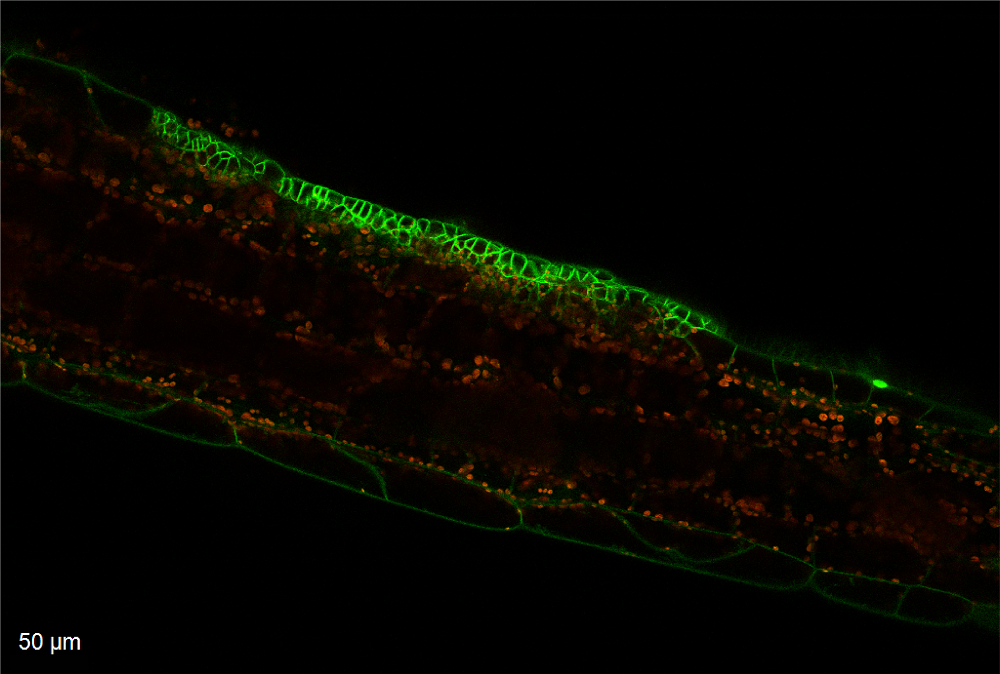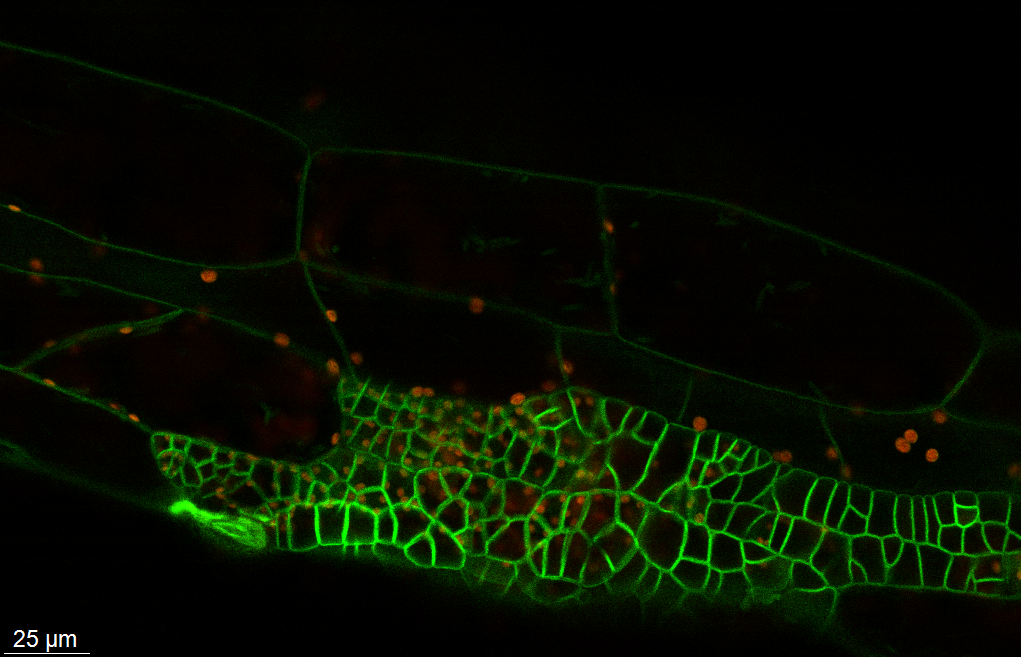
Confocal microscopy image showing an Arabidopsis thaliana seedling that has been heat shocked to induce cell division in the hypocotyl. Image by Mahwish Ejaz.
Investigating how cell division influences decision-making in plants
SLCU researchers Sarah Robinson and James Locke are joining forces to explore a long-debated theory on whether plant development is organised at the cellular scale (cell-theory) or organ scale (organism theory).
The two theories aim to explain the origin and control of multicellularity in higher organisms like plants. The ‘organism theory’ is currently the favoured explanation for plant development due to the observation that mutant plants, where cell division is disrupted, still grow and develop organs relatively normally.
The Robinson and Locke research teams have received a Pioneer Award from the Biotechnology and Biological Sciences Research Council (BBSRC) to challenge this idea.
They will combine methods from cell division, circadian clock, cell communication and synthetic biology to understand how plants make decisions during development. The team will work at the cellular level to investigate how cell-to-cell communication is affected by cell division and if disruption in cell division impacts on plant decision-making.
Cell division impact on cell-to-cell communication
The wonderfully elaborate architecture, enormous diversity of organs and the ability of plants to continually adapt to their changing environment is even more astounding considering that they do not have a centralised decision-making system.
This means each cell in a plant must receive and decide how to react to information from multiple sources and coordinate its growth and development with its neighbours – making cell-to-cell communication very important.
To understand how cell-to-cell communication is affected when cells divide, Dr Robinson’s team is developing new Arabidopsis thaliana lines that allow them to induce cell division in part of the hypocotyl, which is the ‘stem-like’ area of a seedling between the first leaves (cotyledons) and roots, where cell division does not normally occur.
However, the genes used to induce cell division are also involved in other growth and developmental processes, which makes this an extra challenge. To avoid unwanted signals arising due to the gene function itself, Research Associate in the Robinson Group, Dr Mahwish Ejaz has generated Arabidopsis lines to induce cell divisions, using a Cre-Lox recombination system targetting a heat shock promoter.
The heat-shock inducible lines are exposed to a brief 30 second heat shock, which induces a single cell in the hypocotyl to start dividing. Dr Ejaz has successfully induced cell division in small patches of the hypocotyl while the rest of the hypocotyl cells remain unchanged in different Arabidopsis lines.
This produces a hypocotyl with cellular heterogeneity – two distinctly different areas with non-dividing cells and dividing cells. These differences will enable the team to study the cell-to-cell signalling within and between the undivided and divided cells in the hypocotyl.
Confocal microscopy image showing an Arabidopsis thaliana seedling that has been heat shocked to induce cell division in the hypocotyl. Image by Mahwish Ejaz.
Using the circadian clock to study decision-making
The Arabidopsis heat shock induction cell division lines have been developed to also include circadian clock reporter genes. This will test the effects of altering cell division on the plant circadian clock, which is a key timing system that relies on cell-to-cell communication
The circadian clock in plants plays a crucial role in regulating various aspects of their physiology and decision-making processes such as photosynthesis, cell division and timing of developmental transitions throughout a plant’s lifecycle. This internal biological clock helps plants anticipate and adapt to daily and seasonal environmental changes.
Individual plant cells contain their own circadian clock circuits, which self-organise without a master clock. This makes the circadian clock an ideal decision-making system to investigate the impact of cell division.
Dr Locke’s group has previously revealed mechanisms that coordinate these individual cell cycles into rhythmic waves across the entire plant though local cell-to-cell coupling.
The Locke team has also shown cell-to-cell coupling increases in regions where there is a higher density of cells, such as root meristems.
This study will reveal whether modifying cell division frequency can interfere with the pace of clock signal propagation between cells, the robustness of this transmission, and, ultimately, the decision-making processes in plants at tissue and organ scale.
“While we're initially focusing on clock genes in seedling aerial organs, we plan to expand to other signals such as auxin and brassinosteroids and in other organs as well,” Dr Robinson said. “Our findings will help identify which signals are affected by cell division and will shed light on the role of cell division affecting cell communication involved in plant decision-making throughout their lifecycle.”
The Pioneer Award funds research into innovative, early-stage, higher-risk research with the potential to transform our understanding of biological systems. They are funded by the Biotechnology and Biological Sciences Research Council (BBSRC)






